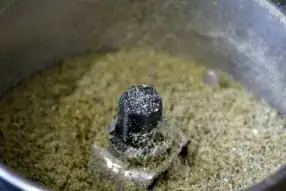If the goal is to follow a South Indian recipe, then dehusking the cardamom and grinding just the seeds would be more authentic than grinding the pod whole. I spent much of my life in India. I studied among South Indians and ate at their homes regularly, and continue to cook Indian food by default even though I haven’t been there in a very long time.
When Indian recipes call for ground cardamom, it is invariably the seeds. The husk is never eaten. Even in rice dishes where a pod or two may be cracked open and added entire, the cardamom is expected to be discarded by the diner in whose portion the pod gets served; it would be considered unusual to eat the whole pod. And I have never seen green-tinged cardamom powder in any Indian grocery store or kitchen; cardamom powder is grey-black, indicating it has been dehusked before grinding.
The husk is also flavorless and has a stringy mouthfeel; it’s like eating straw. Grinding would mitigate that, of course, but why would you want to eat the husk at all? Besides, grinding up the tasteless husk along with the seeds would alter the strength of the cardamom powder, and your measurements would be off as a result. You will not replicate the flavor profile of the mixture correctly if you include the husks.
Edit. This answer gave me pause, since the poster says the tradition is that pods are used whole in South Asia. My experience does not match hers. But to check, I looked up recipes for garam masala (a common spice mixture, though prepared differently in different households) and looked through the first page of Google results. At least one of the recipes does in fact use the whole pod, though most specify using the seeds:
- These sites specify using just the seeds:
- But the recipe on this site uses the entire pod:
The Ministry of Curry recipe seems like an outlier, but provides additional evidence that the entire pod can be used. I have not met anybody who does this IRL.
